Papers by Aliyu Abubakar
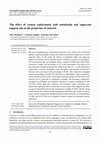
Sustainable Engineering and Innovation
The use of supplementary cementitious materials in the cement and construction industry is growin... more The use of supplementary cementitious materials in the cement and construction industry is growing rapidly owing to the numerous benefits the application of these materials offers. In this study, the effects of metakaolin (MK) and sugarcane bagasse ash (SCBA) used to partially replace cement on concrete are investigated. The experimental plan was designed using a constant 5% MK and 0-20% SCBA contents by weight. The mix design of 1:2:3 and water-binder (w/b) ratio of 0.5 was employed. Samples prepared were tested at the ages of 7, 14, 28, and 60 days respectively. Concrete workability, water absorption, and densities all showed a decrease with an increase in the percentage of SCBA. The compressive strengths at lower percentages of SCBA (5% and 10%) recorded higher values compared to that of 5% MK and 0% SCBA. An increase in the percentage of SCBA above 10% however led to a decrease in compressive strength. The maximum compressive strength of 22.17N/mm2 was obtained at 60 days in con...

Global Journal of Engineering and Technology Advances
In most cases, not all available materials for road construction do meet the nominal requirements... more In most cases, not all available materials for road construction do meet the nominal requirements, as such; stabilization becomes necessary. This study presents the results of a laboratory experiments carried out to assess the effect of mining tailing waste (MTW) as an admixture to ordinary Portland cement (OPC) stabilized Black Cotton Soil (BCS). The MTW was obtained from a tin mining site in Bukuru, Jos South LGA of Plateau State, Nigeria, while the BCS was obtained along Kanawa-Jauro-Gotel road, in Yemaltu-Deba, Gombe, Nigeria. The specimens were prepared by admixing the four blends of OPC stabilized BCS (using 0, 4, 6, and 8% OPC) with stepped percentage of MTW(0, 5, 10, 15 and 20%) by dry weight of BCS. Atterberg’s limits, Sieve analysis, Compaction, soaked California Bearing Ratio (CBR) and Unconfined Compressive Strength (UCS) test were carried out on the natural and stabilized BCS. The BCS classifies A – 7 – 6 (40) and CH (high plasticity clay) according to the American Asso...

Science Forum (Journal of Pure and Applied Sciences) , 2023
This paper tries to investigate the effect of blending animal bone ash (ABA) and metakaolin (MK) ... more This paper tries to investigate the effect of blending animal bone ash (ABA) and metakaolin (MK) on the mortar compressive strength of ternary cement blends. The mortar strengths of the ternary cement blends are influenced by several parameters such as blending ratio, replacement level and curing age. The mortar strength of the ternary cement blend was optimized via response surface methodology using central composite design and Box and Behnken design. Both models were compared to obtain the best strength prediction. Results showed that both models experimental data for the prediction of the mortar strength satisfied second order polynomial regression. The mortar strength of ABA-MK-PLC experienced an increase as the blending ratio between 0.2-0.5 and curing age between 3-60 days whereas a slight reduction in the mortar strength was observed as the replacement level was increased between 7.5-12.5 wt.%. This slight diminution observed despite the high replacement level further proves that pozzolanic activities occurred. The analysis of variance (ANOVA) indicated that the curing age significantly affected the response for both CCD and BBD models respectively with the best mortar strength prediction via CCD. The ANOVA revealed that predicted R 2 (R 2 pred) and R 2 for CCD was very close in comparison with BBD and thus most suitable to describe the mortar compressive strength of the cement blends with R 2 pred of 0.9107. The interactive effect of the blending ratio, replacement level and curing age were also investigated and optimized. The optimum condition for the prediction of the mortar strength of the ternary cement blend were blending ratio 0.423, replacement level 7.565 wt.%, and curing age 60 days.
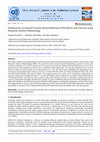
Global Journal of Engineering and Technology Advances, 2023
This study is aimed at the optimization of calcined termite mound material incorporated in mortar... more This study is aimed at the optimization of calcined termite mound material incorporated in mortar and concrete using Response Surfaces Methodology (RSM). The calcined termite mound material substituting cement in mortar and concrete varied from 5 to 15% at interval of 5% in mortar and concrete. Sikament NN was added from 1.0 to 3.0 at interval of 1.0. Test conducted on mortar were: consistency and setting times. For concrete, specimens were cast and tested to failure for all the mixes for curing periods of 3, 7, 28, 60 and 90 days. Modelling and optimization were carried out using Design-Expert software version 11.0 with CTM (5%, 10% and 15%) and Sikament NN (1.0%, 2.0% and 3.0%) levels taking as the input variables. The output responses for mortar were consistency, setting times, on concrete compressive strength test after 3, 7, 28, 60 and 90days curing. Comparison was made to the performance of CTM blended mortar and concrete with controls mortar and concrete in terms of consistency, setting times and in concrete compressive strengths. Results from analysis of variance (ANOVA) indicate that both CTM and Sikament are influential variable in the developed models and all the RSM models are statistically significant in all the factor levels. The optimum mix for mortar was obtained by addition of 2.09 % Sikament NN and 5% CTM replacement with 0.871 desirability. In concrete, 2.05 % Sikament NN and 5% CTM replacement with desirability 0.871 was the optimum.
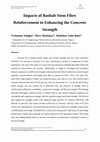
Recent Research Reviews Journal, 2023
Concrete has a limited ductile range, poor tensile strength, and low crack resistance. Therefore,... more Concrete has a limited ductile range, poor tensile strength, and low crack resistance. Therefore, for concrete to function at its best, reinforcing is needed to compensate for these weaknesses. The aim of the study is to assess how the inclusion of baobab stem fibre affects the mechanical characteristics of concrete. Additionally, it sought to investigate the correlation between compressive and flexural strengths when baobab stem fibre is utilised as a reinforcement material. Concrete mixed with baobab stem fibre at volumes of 0.5%, 1.0%, 1.5%, and 2.0%, each with a fibre length of 50mm, was produced using a mix ratio of 1:2:3. The concrete had a constant water/cement ratio of 0.50 and was cured for the periods of 7, 14, 28, 60, and 90 days before testing. Test are carried out to determine how the inclusion of baobab fibre as reinforcement influences workability, compressive strength, and flexural strength. The findings indicated that higher volume fraction of baobab fibre in the concrete influence negatively its workability and compressive strength, but had a positive impact on flexural strength. The flexural and compressive strength results were analysed using Analysis of Variance (ANOVA) with Minitab 19 software. The results revealed coefficients of variation, with R2 values of 97.42% and 93.41% regarding the correlation between flexural and compressive strength, respectively, considering the percentage of baobab fibre volume and curing period. indicating, the percentage baobab fibre volume and curing age are useful predictors of the generated models. The results show that adding baobab fibres to concrete can enhance its performance, especially in terms of flexural strength.

This paper tries to investigate the effect of blending animal bone ash (ABA) and metakaolin (MK) ... more This paper tries to investigate the effect of blending animal bone ash (ABA) and metakaolin (MK) on the mortar compressive strength of ternary cement blends. The mortar strengths of the ternary cement blends are influenced by several parameters such as blending ratio, replacement level and curing age. The mortar strength of the ternary cement blend was optimized via response surface methodology using central composite design and Box and Behnken design. Both models were compared to obtain the best strength prediction. Results showed that both models experimental data for the prediction of the mortar strength satisfied second order polynomial regression. The mortar strength of ABA-MK-PLC experienced an increase as the blending ratio between 0.2-0.5 and curing age between 3-60 days whereas a slight reduction in the mortar strength was observed as the replacement level was increased between 7.5-12.5 wt.%. This slight diminution observed despite the high replacement level further proves that pozzolanic activities occurred. The analysis of variance (ANOVA) indicated that the curing age significantly affected the response for both CCD and BBD models respectively with the best mortar strength prediction via CCD. The ANOVA revealed that predicted R 2 (R 2 pred) and R 2 for CCD was very close in comparison with BBD and thus most suitable to describe the mortar compressive strength of the cement blends with R 2 pred of 0.9107. The interactive effect of the blending ratio, replacement level and curing age were also investigated and optimized. The optimum condition for the prediction of the mortar strength of the ternary cement blend were blending ratio 0.423, replacement level 7.565 wt.%, and curing age 60 days.
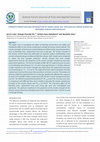
Science Forum (Journal of Pure and Applied Sciences, 2023
This paper tries to investigate the effect of blending animal bone ash (ABA) and metakaolin (MK) ... more This paper tries to investigate the effect of blending animal bone ash (ABA) and metakaolin (MK) on the mortar compressive strength of ternary cement blends. The mortar strengths of the ternary cement blends are influenced by several parameters such as blending ratio, replacement level and curing age. The mortar strength of the ternary cement blend was optimized via response surface methodology using central composite design and Box and Behnken design. Both models were compared to obtain the best strength prediction. Results showed that both models experimental data for the prediction of the mortar strength satisfied second order polynomial regression. The mortar strength of ABA-MK-PLC experienced an increase as the blending ratio between 0.2-0.5 and curing age between 3-60 days whereas a slight reduction in the mortar strength was observed as the replacement level was increased between 7.5-12.5 wt.%. This slight diminution observed despite the high replacement level further proves that pozzolanic activities occurred. The analysis of variance (ANOVA) indicated that the curing age significantly affected the response for both CCD and BBD models respectively with the best mortar strength prediction via CCD. The ANOVA revealed that predicted R 2 (R 2 pred) and R 2 for CCD was very close in comparison with BBD and thus most suitable to describe the mortar compressive strength of the cement blends with R 2 pred of 0.9107. The interactive effect of the blending ratio, replacement level and curing age were also investigated and optimized. The optimum condition for the prediction of the mortar strength of the ternary cement blend were blending ratio 0.423, replacement level 7.565 wt.%, and curing age 60 days.

Global warming, improper solid waste and environment degradations are the major challenges facing... more Global warming, improper solid waste and environment degradations are the major challenges facing humankind. One way to lower the effect global warming is to use less energy intensive materials optimally in construction and proper solid waste disposals to protect the environment from it harmful effects. In this study, the mechanical properties of Pulverized Animal Bone (PAB) and Pulverized Animal Bone Ash (PABA) as cement replacement in concrete were examined and the mechanical properties of concrete containing PAB/PABA optimised using response surfaces methodology (RSM). Central composite Design (CCD) method of experimental design of RSM was used to design the experiment using the key variables in the mechanical properties of Pulverised Animals Bone Ash concrete (PABC) and Pulverised Animals Bone Concrete Ash (PABAC). The variables considered in the model's development are Bone powders percentages replacement of cement in concrete at five levels (5, 10, 15, 20 and 25% levels) and curing age (3, 7, 28, 60 and 90-days). The Test conducted on fresh PABC/BAPAC was slump test while on hardened concrete were, Density, water absorption and compressive strength tests. Analysis of variance (ANOVA) indicates that the variables PAB/PABA and curing age influence the variability in the generated models and all the models are statistically significant at 95% level in all the factors levels. Numerical method of optimisation was applied to determine optimum mix proportions for PABC/PABAC. The optimum mix for PABC was obtained by addition of 5.00% PAB after curing for 42.24-days with 0.736 desirability. In PABAC, 5.00% PABA and 44.87-days curing with desirability 0.736 was the optimum.
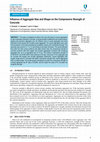
This paper investigates the effect of the size and shape of coarse aggregates on the compressive ... more This paper investigates the effect of the size and shape of coarse aggregates on the compressive strength of concrete. Concrete strength is affected by the surface texture, grading and maximum aggregate size. Six different sizes of coarse aggregate have been selected for both angular and rounded coarse aggregate. The coarse aggregates were used in the production of concrete and tested for workability, density and compressive strength. The specimen was cured for 3, 7, 14, 21 and 28 days by full water immersion. The results indicated that under the same curing conditions and water-cement ratio, the compressive strength of concrete produced with both angular and rounded aggregates increased with increasing aggregate size, up to an aggregate size of 14 mm. The optimum compressive strength of 27.58 N/mm 2 and 25.88 N/mm 2 were achieved at 28 days curing and 14 mm aggregate size for concrete with angular and rounded aggregates respectively. Coarse aggregates with angular shape result in concretes with better compressive strength than coarse aggregates with a rounded shape. The model equation developed to predict the compressive strength of rounded aggregate has R 2 value of 95.66%, and the higher the value of R 2 , the better the model fits the data.
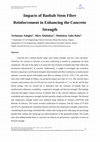
Concrete has a limited ductile range, poor tensile strength, and low crack resistance. Therefore,... more Concrete has a limited ductile range, poor tensile strength, and low crack resistance. Therefore, for concrete to function at its best, reinforcing is needed to compensate for these weaknesses. The aim of the study is to assess how the inclusion of baobab stem fibre affects the mechanical characteristics of concrete. Additionally, it sought to investigate the correlation between compressive and flexural strengths when baobab stem fibre is utilised as a reinforcement material. Concrete mixed with baobab stem fibre at volumes of 0.5%, 1.0%, 1.5%, and 2.0%, each with a fibre length of 50mm, was produced using a mix ratio of 1:2:3. The concrete had a constant water/cement ratio of 0.50 and was cured for the periods of 7, 14, 28, 60, and 90 days before testing. Test are carried out to determine how the inclusion of baobab fibre as reinforcement influences workability, compressive strength, and flexural strength. The findings indicated that higher volume fraction of baobab fibre in the concrete influence negatively its workability and compressive strength, but had a positive impact on flexural strength. The flexural and compressive strength results were analysed using Analysis of Variance (ANOVA) with Minitab 19 software. The results revealed coefficients of variation, with R2 values of 97.42% and 93.41% regarding the correlation between flexural and compressive strength, respectively, considering the percentage of baobab fibre volume and curing period. indicating, the percentage baobab fibre volume and curing age are useful predictors of the generated models. The results show that adding baobab fibres to concrete can enhance its performance, especially in terms of flexural strength.

International Journal of Sustainable and Green Energy, 2021
The purpose of this study is to assess the Embodied Energy (EE) and Carbon IV Oxide (CO2) emissio... more The purpose of this study is to assess the Embodied Energy (EE) and Carbon IV Oxide (CO2) emissions saving potentials of Corn Cob Ash (CCA) as partial replacement of Ordinary Portland Cement (OPC) in concrete. Cement manufacture is energy intensive and contributes considerable amount of CO2 emissions into the atmosphere. Globally, Concrete is the most consumed man-made material and about 95% of CO2 emissions from a cubic meter of concrete are from cement manufacturing. In this study, the experimental plan was designed to carry out compressive strength, flexural strength, density and water absorption tests on the concrete using 0, 5, 10, 15 and 20% CCA contents to replace OPC. Inventory method of analysis was used to determine the EE and CO2 emission for all the concrete mixes. The results indicated that the water absorption, density, compressive and flexural strength decreased with increase in CCA content and increased with curing period. The optimum blend was obtained at 10% CCA an...
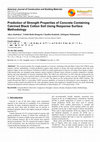
American Journal of Materials Synthesis and Processing, 2020
This research predicts the strength properties of concrete containing Calcined Black Cotton Soil ... more This research predicts the strength properties of concrete containing Calcined Black Cotton Soil (CBCS) using response surface methodology. Cement production requires large amount of energy and emits greenhouse gases that have negative impact on the environment. Utilization of CBCS as cement replacement in concrete will reduce these negative impact. Experimental plan was designed using response surface method in Design Expert software to predict compressive strength, density and water absorption of concrete containing CBCS. The CBCS was varied from 5 to 20% while the curing period was varied and 7 to 28 days. Face-centered central composite design method of response surface was used. The design consists of two design factors at three levels (coded as-1, 0, +1) each. The factors are the curing period, and the CBCS contents. The results showed that CBCS is a pozzolana. CBCS increases durability of concrete by decreasing its water absorption. All the response surface models developed for the water absorption, density and compressive strength showed very good relationship between the predictors and the responses with coefficients of determination, R 2 ˃ 0.94 and p-values ˂ 0.05.
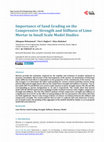
Open Journal of Civil Engineering, 2015
Mortars provide the continuity required for the stability and exclusion of weather elements in ma... more Mortars provide the continuity required for the stability and exclusion of weather elements in masonry assemblies. But because of the heterogeneity of the mortar, its mechanism of behaviour under different load effects is dependent on the properties of the constituents of the mortar. The aim of paper is to determine the effect sand grading for various cement-sand-lime mortar designations (BS) and strength classes (EC) on the compressive strength and stiffness of mortar. Two silica sands; HST 95 and HST60 were used to make mortars in three strength classes: M2, M4 and M6, corresponding to mortar designations iv, iii and ii respectively. The results show that mortar made with the HST60 sand (coarser grading) usually resulted in mortar with a higher compressive strength and stiffness. The One Way ANOVA analysis of both compressive strength and stiffness at a significance level of 5% on the effect of sand grading on the two parameters also shows that they are both significant. There is also strong evidence of a linear correlation between the stiffness and compressive strength. The results indicate that in order to replicate full scale behaviour of masonry at model scales, the grading of fine aggregate in the models should be similar so as to properly model full scale behavior.
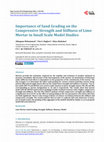
Mortars provide the continuity required for the stability and exclusion of weather elements in ma... more Mortars provide the continuity required for the stability and exclusion of weather elements in masonry assemblies. But because of the heterogeneity of the mortar, its mechanism of behaviour under different load effects is dependent on the properties of the constituents of the mortar. The aim of paper is to determine the effect sand grading for various cement-sand-lime mortar designations (BS) and strength classes (EC) on the compressive strength and stiffness of mortar. Two si-lica sands; HST 95 and HST60 were used to make mortars in three strength classes: M2, M4 and M6, corresponding to mortar designations iv, iii and ii respectively. The results show that mortar made with the HST60 sand (coarser grading) usually resulted in mortar with a higher compressive strength and stiffness. The One Way ANOVA analysis of both compressive strength and stiffness at a significance level of 5% on the effect of sand grading on the two parameters also shows that they are both significant. There is also strong evidence of a linear correlation between the stiffness and compressive strength. The results indicate that in order to replicate full scale behaviour of masonry at model scales, the grading of fine aggregate in the models should be similar so as to properly model full scale behavior.
Conference Presentations by Aliyu Abubakar
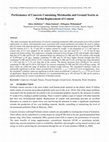
Proceedings of NBRRI International Conf. on Sustainable Development Goals & Nigerian Construction Industry, 2018
This study investigates the performance of concrete containing metakaolin (MK) and ground scoria ... more This study investigates the performance of concrete containing metakaolin (MK) and ground scoria (GS) as partial replacement of cement. Environmental issues associated with cement production necessitate the need to replace part of cement with materials that have less environmental impact. Experimental plan was designed using 5% MK and GS contents of 0, 5, 10, 15 and 20% to replace cement by weight. A mix proportion of 1:2:3 and water-tocement ratio of 0.5 were adopted for the research. Samples were cast and cured for 3, 7, 14, 28 and 60 days respectively before testing. The compressive strengths increased at lower dosage of GS with strength values higher than that of 5% MK and 0% GS. The optimum blend was obtained at 5% MK and 10% GS contents with strength of 28.99N/mm 2 at 60 days .Samples containing 5% MK and 5% GS have higher flexural strength than those containing 5% MK and 0% GS by 14.4%. Concrete containing 5% MK and 5% GS, at 60 days has water absorption of 1.54% and this is 71.1% less than that of the control. The density decreases from 2362Kg/m 3 for concrete containing 5% MK and 5% GS to 2245 Kg/m 3 for concrete containing 5% MK and 20% GS at 60 days curing.. All these values are within the range of densities for normal weight concrete. The calculated F-statistics values are statistically significant as all the values exceeded the F-critical (F2, 22, 0.05 = 3.44) at 5% level of significance. Also, the calculated T-statistics values are significant as all the values exceeded the T-critical (T24, 0.05 = 2.797) at 5% level of significance. Based on the results obtained, it is recommended that up to 10% GS and 5% MK can be used as a partial replacement for cement in production of blended cements.

This study analyzes the Embodied Energy (EE) and Carbon IV Oxide (CO2) emission of Sandcrete Bloc... more This study analyzes the Embodied Energy (EE) and Carbon IV Oxide (CO2) emission of Sandcrete Blocks (SCB) and Compressed Earth Bricks (CEB) houses. Energy and CO2 are emitted in the process of manufacture, transportation and construction of buildings materials. These energies and carbon dioxide are embodied in the materials. Thus, an exploratory research method was used to assess the EE and CO2 emission impacts of building materials for the two types of houses in Nigeria. A detailed inventory analysis approach was used with EE and CO2 emission factors obtained from Inventory of Carbon and Energy (ICE) database. The findings revealed the EE and CO2 emission for the CEB are 436,343.49MJ (2,288.59 MJ/m 2) and 30,821.09 KgCO2 (161.65 KgCO2/m 2) while for the SCB house are 632,298.58 MJ (3,316.37 MJ/m 2) and 52,897.82 KgCO2 (277.45 KgCO2/m 2) respectively. Thus, the SCB house expends 30.99% more EE and emits 41.73% more embodied CO2 than CEB. The comparison revealed that the CEB house is more sustainable and environmentally friendly in terms of EE and CO2 emission than the SCB house. Also these findings indicate the importance of considering EE and CO2 emissions impacts of various materials before using them in constructions.








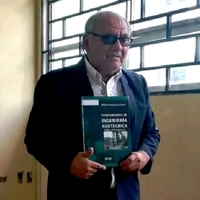

Uploads
Papers by Aliyu Abubakar
Conference Presentations by Aliyu Abubakar